This is the second installment covering the 11-Day Power Play: Fighting cancer with the world’s longest hockey game. To read the first, click here.
After more than a year in the making, the puck finally dropped Thursday, June 22, 2017 at approximately 9:01 p.m., officially starting the 11-Day Power Play. Wednesday, June 28 marks the halfway point–the sixth of eleven consecutive days of the nonstop, 24-hours-a-day hockey game. The game is being held in Buffalo, New York at the HarborCenter, a state-of-the-art facility next to KeyBank Center where the Buffalo Sabres play. All monies raised will go toward research at Roswell Park Cancer Institute.
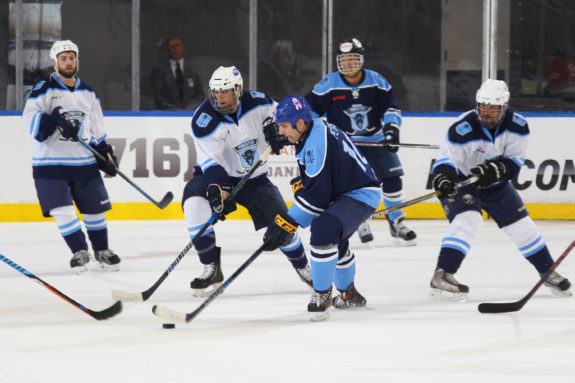
I recently caught up with Amy and Mike Lesakowski, the event’s creators, to hear how things have been progressing. Mike had just come off of a four and a half hour shift that ended at 12:50 p.m. and was due back on at 5:40 p.m. for another. Each player experiences a similar quick turnaround a few times during the event.
Opening Ceremonies
Doors to the event opened at 7 p.m. last Thursday and Western New York showed up–the place was packed. “We actually had to stop letting people in,” said event co-founder Amy Lesakowski.
“Obviously we’re not professional hockey players. Most of the guys have never played in front of anybody so it was a cool vibe to come out on the ice like that. It really was an unbelievable feeling,” said Mike. “There were so many people and tons of energy in the air.”
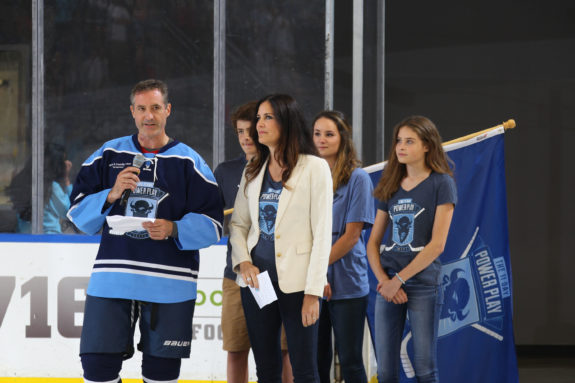
Opening ceremonies started at 8 p.m., with remarks by both Lesakowskis and by Buffalo’s Mayor, Byron Brown.
A few hours earlier in the day, Mike found out that they had reached their goal of raising $1 million ($1.017 million to be exact), but had kept the news a secret until the opening ceremonies.
“When I was done with my speech, Mike leaned over and whispered, ‘Hon, we’re at a million seventeen thousand,’” said Amy Lesakowski. “It was the first time I knew. I wanted to announce it perfectly to the crowd but I was so excited I wanted to cry. I got the message out. It was a chilling moment.“
The Impact of Every Dollar Raised
“Everybody was curious afterward, asking who was the donor that donated that big lump sum to get us there. The ironic thing is that there wasn’t one person. It was the accumulation of so many different people… just multiple, multiple donations that had come in those last few days.”
 It just goes to show that every donation, no matter how big or small, really adds up. Every single dollar is important; as their video explains, Roswell Park can leverage an additional $13 in research grant funding for every dollar donated. The $1 million raised by this event for cancer research could potentially turn into $13 million for Roswell!
It just goes to show that every donation, no matter how big or small, really adds up. Every single dollar is important; as their video explains, Roswell Park can leverage an additional $13 in research grant funding for every dollar donated. The $1 million raised by this event for cancer research could potentially turn into $13 million for Roswell!
“We want people to keep donating. We want to blow it out of the water,” said Amy. Monetary donations are still being accepted online. Additional funds are still being raised through the sale of merchandise and of their locally brewed beer.
“I’ll tell ya what,” said Mike, “it’s much more now, because every time I get off my shift, I look on my phone and I just did it ten minutes ago and there was probably $700 in donations I got in the last 24 hours. Every time I come back from a shift–you put the phone down and don’t see it for five hours–it’s pretty cool. And I’m one of forty players, so I know that the other guys are having the same enjoyment of getting more donations as we go.”
Singing Their Hearts Out
The Canadian and American anthems were sung by two of player Mike Lawley’s daughters and two of their close friends. “I think people were just shocked when they opened her mouths. You see these kids walking out and you’re like ok… and then it was the most beautiful thing you’ve ever heard. It was just beautiful,” said Amy.
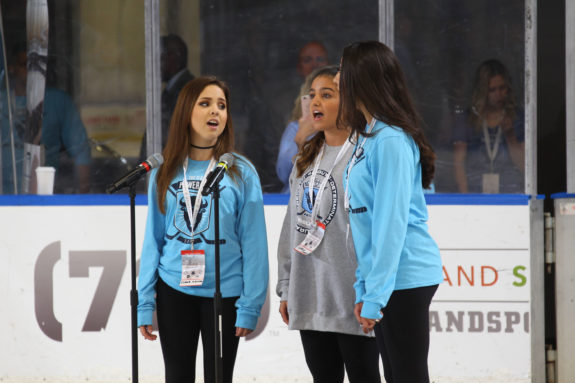
Mike, aka, “Lawls,” has raised $50,000 for the 11-Day Power Play in honor of his wife, Kirsten. She is a breast cancer survivor who was diagnosed at 38 when their four daughters were eight and under. “If she could handle 11 months of chemo and radiation, I can handle 11 days of playing hockey,” said Lawls.
The Ceremonial Puck Drop
Peter Merlo and Andrew “Drew” Case, two cancer survivors treated at Roswell, joined Emmett Jakubowski to take the opening faceoff. Emmett is the 11-Day Power Play’s ambassador. “It was a no brainer who to ask to ask for the puck drop,” said Amy.
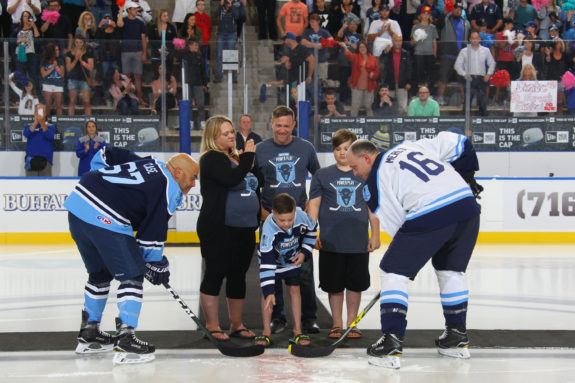
Emmett is an ambassador and motivator for the 11-Day Power Play. The 11-year old 6th grade student attends the Fredrick Law Olmsted school in Buffalo, New York. He’s also passionate about playing ice hockey.
In November 2015, Emmett was diagnosed with two forms of Leukemia, ALL and CML. He received a bone marrow transplant in February 2016 from a 33-year old male who lives somewhere in the United States. He relapsed 80 days after the transplant and was given healthy white blood cells called Leukocytes. He developed Graft vs Host disease and has remained in remission since June 2016.
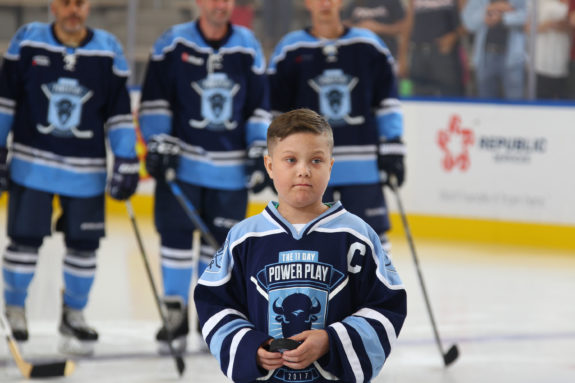
“To see a young man like Emmett fighting cancer the way he has… I think {Emmett’s} quote was, he’s fought long enough. Now it’s time for us to do it,” said player Andy Tokasz.
Guest Play-By-Play Announcers
Once the official puck dropped to start the game, things got even more intense. Longtime Buffalo Sabres play-by-play announcer Rick Jeanneret and fellow analyst and former Sabre Rob Ray called the game for the first hour.
Jeanneret, an icon in Buffalo, is a cancer survivor himself having been diagnosed with Stage 3 throat cancer in July 2014. Four months later, following a CAT scan, he announced he was clear of cancer and returned to the broadcast booth shortly thereafter.
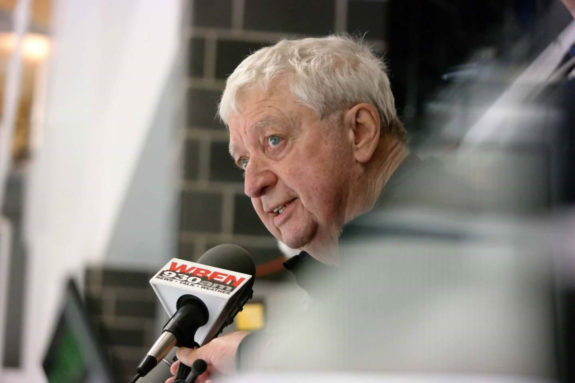
“RJ was great. He called the game over the public announcement system so it was heard throughout the building. It was kind of cool to hear him call out our names,” said Mike Lesakowski. “Rob Ray did his typical between the glass thing and he was busting the guys’ chops, having a lot of fun. The guys got to razz him a little bit and they’d go back and forth.”
“It’s a moment you will never ever forget,” said one of the players, Allan Davis, during a segment on WGR550, the radio home of the Sabres.
Piling on the Hat Tricks
At the time this article was submitted, after a little more than five days, the score was Blue 802, White 800.
The individual stats are harder to get, since there are so many goals and the stats take time to tabulate. The top three goal scorers are #85 Kenny Corp, #10 Geoff Peters and #11 Chris Boron. Each of them have more than 45 goals. In other words, they’ve each scored over a dozen hat tricks.
“Corpy” has raised more than $10,000 to honor many family members and friends as well as those who have lost loved ones to cancer.
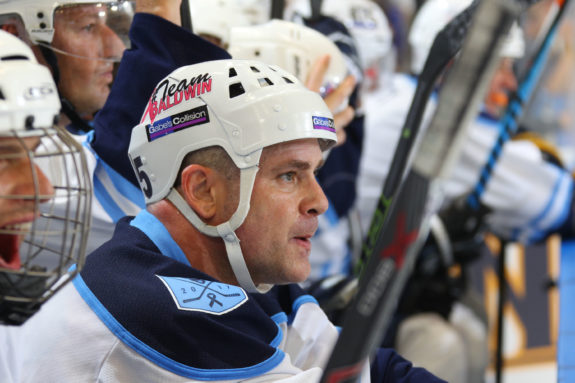
Peters, brother of former-Sabre Andrew Peters, is playing on behalf of all those who have been diagnosed with breast cancer, including his sister-in-law, and set his goal at raising $20,000 for cancer research.
Chris “CB” Boron is on the 11-Day Power Play Committee and promised to raise $10,000 in memory of his grandmother Manda Gajer, in honor of his sister who is a survivor, in appreciation of those researching, treating and helping to find a cure.
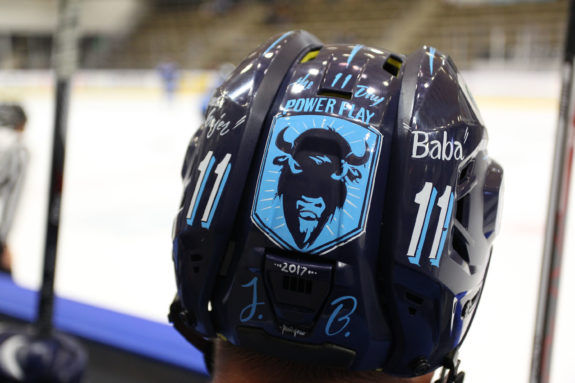
Excelsior Orthopaedics, the official medical provider of The 11-Day Power Play, has taped blisters more than 1,500 times with more roles of tape than they can count. The players have consumed more than 120 cases of water, 70 cases of Gatorade and 50 cases of Pedialyte, plus recovery protein drinks and bars from Iovate.
The Record
In addition to raising $1 million, the 11-Day Power Play has sights on besting the current Guinness World Record for the world’s longest continuous hockey game. The current record took place in February of 2015 and lasted 250 hours, 3 minutes and 20 seconds. The game was played outdoors and raised money for the Alberta Cancer Foundation. According to Mike Lesakowski, the 11-Day Power Play plans to play for about 251 hours.
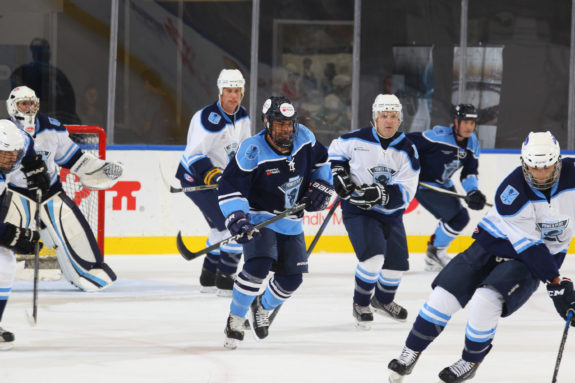
The game must follow the same rules as a National Hockey League game, except players are on the ice 24 hours a day for 11 days. Teams are composed of five skaters, a goalie and one sub, the minimum for a game. All 40 players are each playing at least 19 four-and-a-half-hour shifts, with breaks ranging from four and a half hours to nine hours.
There are two goalies per team. In addition, each skater is scheduled to take a turn playing net at least once.
A Physical Grind
The players must live on site at the HarborCenter for all 11 days. They are sleeping in makeshift dormitories within two locker rooms, a referee room and a storage room.
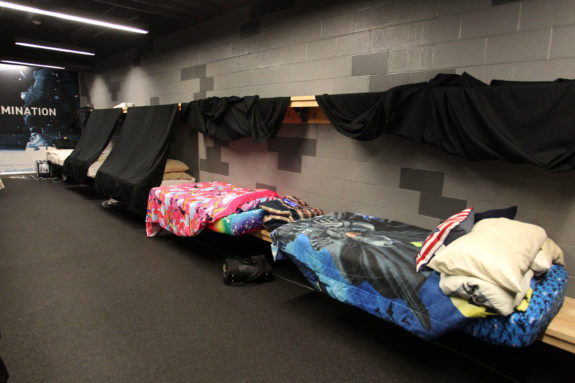
“Most of the guys are good. We’re obviously a little bit sore. We have a full medical staff which has been… I don’t know how we would do this without them. Excelsior Orthopedics has been great. If the guys need anything to be taped up, have bumps or bruises, they’ve got us covered,” said Mike Lesakowski. “It’s mostly feet oriented. Hockey skates weren’t meant to be worn five hours at a time, so your feet get mangled a little bit.”
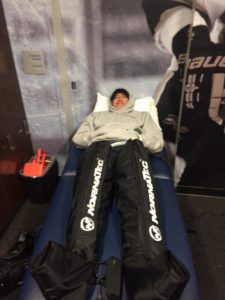
Two of the 40 players have had to go to the hospital, missing their shifts. One of them had a 102 fever. “He’s fighting something. Now his fever’s gone and he’s eating really well. We’re hoping it’s a 24-hour thing. He’s expected to go back on the ice for his next shift,” said Amy. “With Guinness, you can leave the building for medical attention but then you have to come directly back. That happened with one of our guys last night/early morning.”
“The other gentleman has been out since Saturday and we’re hoping he’ll be back in the next couple days.” Fortunately, they’re on opposite teams so it’s not taxing one side more than the other.
“These guys do not want to leave; they want to be back on the ice,” said Mike. The remaining 38 players are totally pitching in for each other. They’re asking who’s in the best shape right now. Who can spare an extra hour on the ice after a four-hour shift?
“We’ve had to have the guys cover for them. So they’re actually skating more than four hours on, eight hours off. They’ve been asked to put in an extra hour or stay an hour late. Go in an hour early. So they’re all helping, because right now, we have two players that cannot play.”
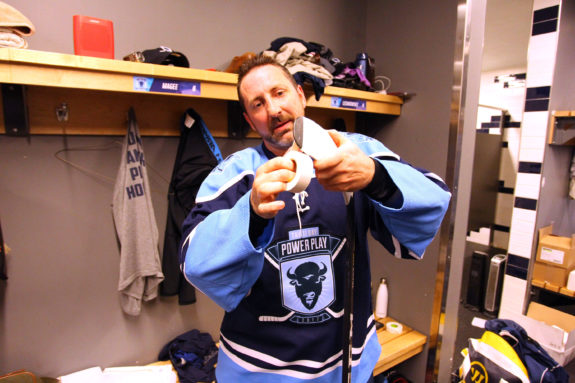
A Mental Grind
According to Mike, mentally it’s starting to become a challenge now. “The first few days weren’t that bad. The broken sleep patterns… that’s probably the most difficult,” said Mike In between yawns. “The way we organized it, the way our schedule is, nobody has a set time – we did it on purpose to have guys all kind of equally share in the times that they play, whether it’s morning noon or night. So we sleep when we can. So the guys that I skated with this morning, I have a four and a half hour break, but they have a nine-hour break. So a lot of them went back and crashed out to get some rest. But tonight, I won’t get to rest until after we play. I’ll be ready to crash.”
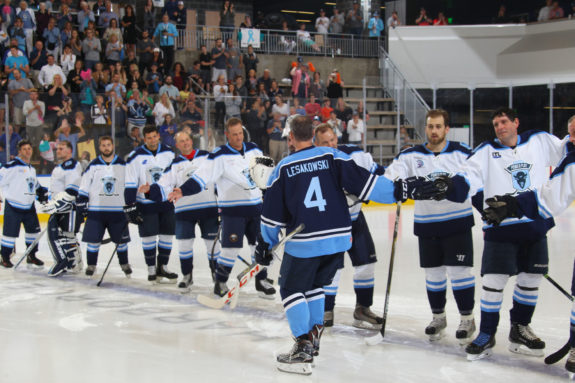
“The guys in Alberta (who hold the current Guinness World Record) said the first three or four days would be the easiest and I’d have to agree with that to this point. We’re just about halfway, so in the last 24-48 hours the guys started getting sore…their feet and hands. But because we have the medical experts here and we’re icing and wrapping and doing that type of stuff… I think the guys understand we’re in a groove. And that’s just kind of the way it is.”
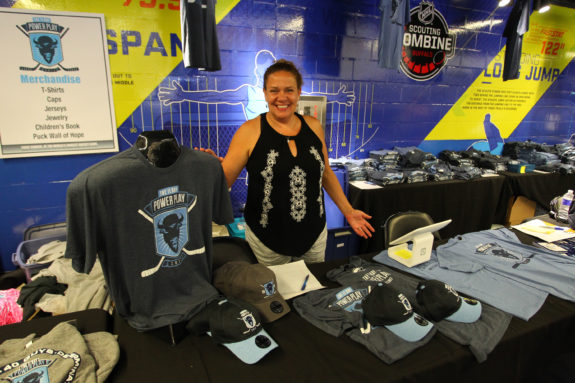
Behind the scenes, 11-Day Power Play event coordinator Sara Schumacher and co-founder Amy Lesakowski are also living in the HarborCenter facilities for the duration of the game. They’re monitoring all needs and coordinating an immense behind the scenes network of support, including meals, volunteering and fundraising activities.
Sticking Together
Injuries are part of the game. Just a few days before the 11-Day Power Play started, David Hage, one of the players who had raised more than $10,000 for the event, broke his collarbone playing hockey. He was replaced at the last minute. Former Sabres’ captain Michael Peca had to back out a few months ago per his doctor’s recommendation. The long hours would have required surgery for injuries from his playing career.
“I liken it to a player who got injured right before a long playoff run,” said Peca, who will serve as an honorary coach. “Though you can’t be a part of it on the ice, you still want to make sure you’re a positive influence in doing everything you can to help out off it.”
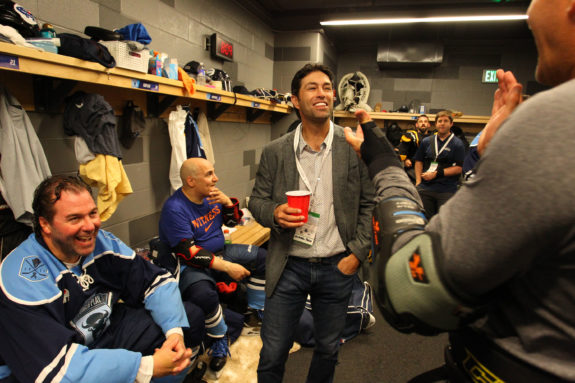
Spanning 14 years, Peca played in 864 NHL regular season games or roughly 36 straight days of hockey. By contrast, that’s a just a little over three times more than what will be played during this record-setting event that lasts eleven days.
“Once you start thinking about all the things that go into it, it does sound a little crazy,” Peca said. “But you know what, sometimes if you want to do something special for other people, you might have to do something a bit crazy to achieve it.”
The Goalie Code
Of the forty players, there are 36 skaters and four goalies. Each player must take at least one four-hour shift tending the net, full pads and all. When I asked Mike if he had his shift, he laughed. “I was afraid you were going to ask that. It was fun… a lot of fun. I think we have a kind of understanding that when someone’s in there that’s not a goalie, you play a little bit differently. You take more outside shots. You don’t come in and deke… that type of stuff. It’s an unspoken rule.”
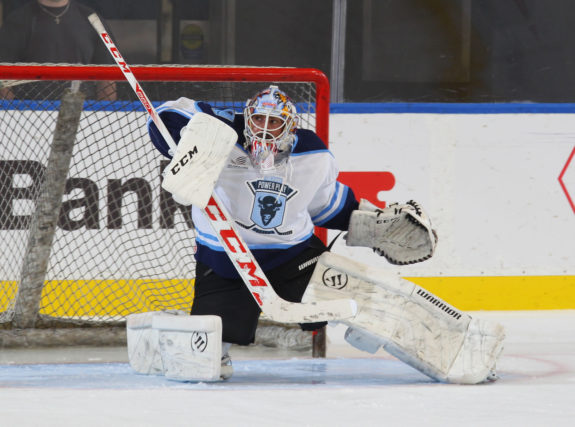
Though it wasn’t easy to wear all the heavy gear, Mike considered it to be a little bit of a break because “it was more standing and moving around than skating.”
I asked him about his goals against average and he laughed again. “If I had to guess… I probably let in about 40 goals,” he chuckled. “The razzing going on is constant. It’s like white noise. We’re constantly on each other in a fun way.”
Get Involved
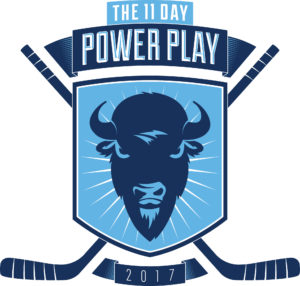 There’s still plenty of time to be a part of the 11-Day Power Play. If you’re able to make the drive to Buffalo and check it out, stop by and support the players and the cause. There’s live music pretty much every day, including a headline concert on Wednesday night by Dave Schulz and C.O. Jones to mark the event’s halfway point. Admission is free except for the night of the Schulz concert.
There’s still plenty of time to be a part of the 11-Day Power Play. If you’re able to make the drive to Buffalo and check it out, stop by and support the players and the cause. There’s live music pretty much every day, including a headline concert on Wednesday night by Dave Schulz and C.O. Jones to mark the event’s halfway point. Admission is free except for the night of the Schulz concert.
“We set that up as a rallying point,” said Lesakowski. “When planning the event way back when, we thought it would give us a shot of adrenaline.”
Mike is happy that there are always people watching in the stands. “Sometimes it’s two. Sometimes it’s four. This afternoon we probably had 100 people here. Some bring signs. Some are friends and family.”
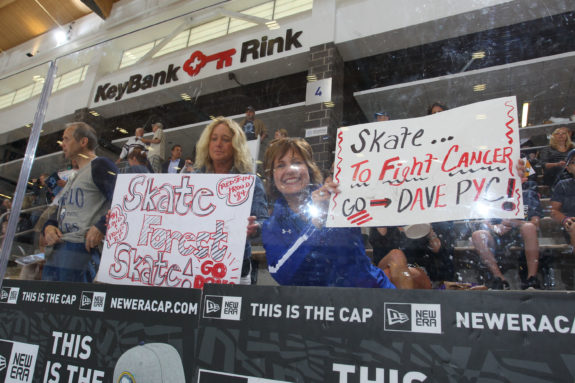
“Today we had a lady come in wearing a headband… a bandana type, obviously with no hair, and she was a cancer patient. She was not very old. She was probably in her thirties and she had a couple of kids with her that were probably four and six and her husband. And she just came down because she’s going through cancer treatment. That was pretty cool. Those are the things that make it… when it’s hard, it makes it kind of easy.”